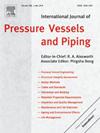Mode I stress intensity factors for pressurized pipes with multiple cracks: Two coplanar identical semi-elliptical internal surface cracks in the longitudinal direction
IF 3
2区 工程技术
Q2 ENGINEERING, MECHANICAL
International Journal of Pressure Vessels and Piping
Pub Date : 2025-03-26
DOI:10.1016/j.ijpvp.2025.105520
引用次数: 0
Abstract
Pipe failures often result from clustered or multiple cracks, with severity quantified by the stress intensity factor (K). For pressurized pipes with multiple cracks, specifically two coplanar identical semi-elliptical internal surface cracks oriented longitudinally, API 579–1/ASME FFS-1 suggests combining cracks into a single equivalent crack when the crack spacing is small. However, the interaction mechanism and criteria for this approach remain unclear. This study used finite element analysis to investigate the Mode I stress intensity factor (KI) in pressurized pipes with two coplanar semi-elliptical cracks. Various factors influencing interaction were analyzed, including pipe dimensions, crack depths, crack geometries, crack spacings, and internal pressures. Results showed a rapid decrease in KI near the surface point of crack due to the free surface effect. As crack spacing decreased, interaction effects increased, leading to higher KI values for multiple cracks compared to a single crack. Interaction was most pronounced at the surface point where cracks connect, caused by stress superposition. The threshold spacing for no interaction increased with crack depth and was consistent across different pipe dimensions and crack geometries. Reducing internal pressure effectively mitigated interaction effects. These findings offer criteria for evaluating crack interaction and guidance for maintaining the structural integrity of pressurized pipes with multiple cracks.
多裂纹受压管道的I型应力强度因子:纵向上两个共面相同的半椭圆内表面裂纹
管道故障通常由聚集或多个裂纹引起,其严重程度由应力强度因子(K)量化。对于具有多个裂纹的受压管道,特别是两个共面相同的半椭圆内表面纵向裂纹,API 579-1 /ASME FFS-1建议在裂纹间距较小时将裂纹合并为单个等效裂纹。然而,这种方法的相互作用机制和标准仍不清楚。本文采用有限元方法研究了含两共面半椭圆裂纹的受压管道的I型应力强度因子。分析了影响相互作用的各种因素,包括管道尺寸、裂纹深度、裂纹几何形状、裂纹间距和内部压力。结果表明,由于自由表面效应,裂纹表面附近的KI值迅速下降。随着裂纹间距的减小,相互作用效应增加,导致多个裂纹的KI值高于单个裂纹。相互作用在裂缝连接的表面点最为明显,这是由应力叠加引起的。不相互作用的阈值间距随着裂纹深度的增加而增加,并且在不同的管道尺寸和裂纹几何形状中是一致的。降低内部压力有效地缓解了相互作用的影响。这些研究结果为裂纹相互作用的评价提供了标准,并为保持多裂纹受压管道的结构完整性提供了指导。
本文章由计算机程序翻译,如有差异,请以英文原文为准。
求助全文
约1分钟内获得全文
求助全文
来源期刊
CiteScore
5.30
自引率
13.30%
发文量
208
审稿时长
17 months
期刊介绍:
Pressure vessel engineering technology is of importance in many branches of industry. This journal publishes the latest research results and related information on all its associated aspects, with particular emphasis on the structural integrity assessment, maintenance and life extension of pressurised process engineering plants.
The anticipated coverage of the International Journal of Pressure Vessels and Piping ranges from simple mass-produced pressure vessels to large custom-built vessels and tanks. Pressure vessels technology is a developing field, and contributions on the following topics will therefore be welcome:
• Pressure vessel engineering
• Structural integrity assessment
• Design methods
• Codes and standards
• Fabrication and welding
• Materials properties requirements
• Inspection and quality management
• Maintenance and life extension
• Ageing and environmental effects
• Life management
Of particular importance are papers covering aspects of significant practical application which could lead to major improvements in economy, reliability and useful life. While most accepted papers represent the results of original applied research, critical reviews of topical interest by world-leading experts will also appear from time to time.
International Journal of Pressure Vessels and Piping is indispensable reading for engineering professionals involved in the energy, petrochemicals, process plant, transport, aerospace and related industries; for manufacturers of pressure vessels and ancillary equipment; and for academics pursuing research in these areas.

 求助内容:
求助内容: 应助结果提醒方式:
应助结果提醒方式:


